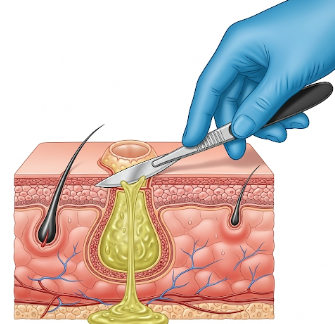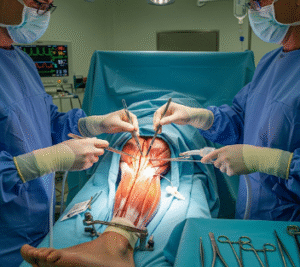Overview
Abscess incision and drainage (I&D) is a minor surgical procedure used to treat localized collections of pus caused by bacterial infections. Abscesses can form in the skin, soft tissues, or deeper organs, leading to pain, swelling, redness, and sometimes fever.
In Korea, I&D procedures are performed in hospitals and outpatient clinics by experienced surgeons or dermatologists, using sterile techniques to ensure safe, effective drainage and rapid recovery. The procedure is quick, often outpatient, and highly effective when combined with proper post-procedure care.
What is Abscess Incision and Drainage?
An abscess is a localized infection filled with pus, usually caused by bacteria like Staphylococcus aureus. When an abscess does not resolve naturally, surgical intervention is necessary.
Incision and drainage (I&D) involves:
- Making a small cut in the abscess to allow pus to escape
- Cleaning the cavity to remove infectious material
- Promoting healing and preventing the infection from spreading
Key points:
- Commonly performed on skin, subcutaneous tissues, or deeper organs
- Provides rapid pain relief and infection control
- Often combined with antibiotic therapy, especially for large or complicated abscesses
- Goal: eliminate pus, reduce inflammation, and prevent complications
What are the benefits?
- Immediate pain relief by releasing pressure from the abscess
- Prevents spread of infection to surrounding tissues or bloodstream
- Promotes faster healing and reduces scarring risk
- ✅ Short procedure, often completed in minutes under local anesthesia
- ✅ Can be performed safely in outpatient settings
- ✅ In Korea, advanced techniques ensure minimal recurrence and high safety standards
Procedure Details
1) How should I prepare for Abscess Incision and Drainage?
- ➤ Consult a healthcare provider to assess abscess size, depth, and location
- ➤ Discuss allergies, medications, and medical history
- ➤ Procedure usually performed under local anesthesia, so no fasting is required in most cases
- ➤ Clean the skin area as instructed by the clinician
- ➤ Arrange for post-procedure care, including dressing changes
2) What happens during the procedure Abscess Incision and Drainage?
- ✅ Area is cleaned and sterilized
- ✅ Local anesthesia is administered to numb the area
- ✅ Surgeon makes a small incision to open the abscess
- ✅ Pus is drained, and the cavity is cleaned thoroughly
- ✅ Culture samples may be taken to guide antibiotic therapy
- ✅ The wound may be packed with sterile gauze to maintain drainage if necessary
- ✅ Procedure usually takes 10–20 minutes depending on abscess size
3) What happens after an Abscess Incision and Drainage?
- ➤ Pain and swelling may persist for a few days, managed with painkillers
- ➤ Dressing changes are required to keep the wound clean
- ➤ Antibiotics may be prescribed based on infection severity or culture results
- ➤ Avoid pressure, friction, or contamination at the site
- ➤ Healing typically occurs within 1–2 weeks, depending on abscess size and location
Risks / Benefits
Potential Risks:
- ➤ Infection at incision site or deeper tissues
- ➤ Bleeding or hematoma formation
- ➤ Pain or discomfort at the site
- ➤ Scar formation
- ➤ Rare: systemic infection if untreated
Benefits:
- ✅ Immediate pain relief and pus removal
- ✅ Prevents spread of infection
- ✅ Short, safe, and effective procedure
- ✅ Minimal downtime; most patients return to normal activities quickly
- ✅ In Korea, sterile technique and skilled surgeons minimize recurrence and complications
Recovery and Outlook
- Hospital stay: Usually outpatient; no overnight stay required
- Activity: Light activity; avoid trauma to the treated area
- Wound care: Follow instructions for cleaning, dressing changes, and monitoring for signs of infection
- Full recovery: Typically within 7–14 days, depending on abscess size
- Follow-up: Necessary to ensure complete healing and no recurrence
- Lifestyle: Maintain good hygiene, manage underlying health conditions, and seek care promptly for future infections
When To Call the Doctor
- ➤ Increased redness, swelling, or warmth around the wound
- ➤ Pus or bleeding that persists or worsens
- ➤ Fever or chills indicating systemic infection
- ➤ Severe pain not relieved by medication
- ➤ Recurrent abscess formation or complications
Best Korea Option / Process
- ✅ Korea provides specialized hospitals and clinics for abscess management
- ✅ Procedures are performed using sterile technique, skilled surgeons, and modern wound care protocols
- ✅ Outpatient procedures ensure minimal disruption to daily life
- ✅ Post-procedure care includes wound monitoring, dressing management, and antibiotics if needed
- ✅ International patients benefit from VIP services, English-speaking staff, and coordinated care
- ✅ High success rates and rapid recovery make Korea a preferred destination for abscess treatment













